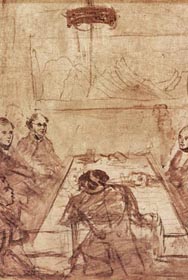The Society was inaugurated on 13 November 1807 at a dinner at the Freemasons Tavern, which formerly stood at the site of the modern Connaught Rooms, Great Queen Street, Covent Garden.
 The minutes of the meeting record that there were thirteen founder members:
The minutes of the meeting record that there were thirteen founder members:
- Arthur Aikin (1773-1854)
- William Allen (1770-1843)
- William Babington (1756-1833)
- Humphry Davy (1778-1829)
- Comte Jacques-Louis de Bournon (1751-1825)
- James Franck (d. 1843)
- George Bellas Greenough (1778-1855)
- Richard Knight (1768-1844)
- James Laird (d. 1840)
- James Parkinson (1755-1824)
- William Hasledine Pepys (1775-1856)
- Richard Phillips (1778-1851)
- William Phillips (1773-1828)
This meeting resolved:
'That there be forthwith instituted a Geological Society for the purpose of making geologists acquainted with each other, of stimulating their zeal, of inducing them to adopt one nomenclature, of facilitating the communications of new facts and of ascertaining what is known in their science and what remains to be discovered.'
These aims were incorporated in the first constitution of the Society, formally adopted at a meeting on 1 January 1808. Soon after its foundation the Society began to accumulate a library and a collection of minerals, rocks and fossils. These latter were housed in a cabinet presented by Dr William Babington, one of the founder members of the Society. In 1809 the Society moved into rented premises at 4 Garden Court, Temple, and in 1810 to 3 Lincoln's Inn Fields, where it shared larger premises with the Medical and Chirurgical Society.
On 1 June 1810 the Society's first Trustees were appointed and later in the same month, 14 June, the first meeting of the Council took place.The Council resolved that the most important communications made to the Society should be published. Accordingly the first volume of the transactions of the Geological Society was published in 1811.
With the increase in membership and activities of the Society it was found necessary to appoint the first permanent officer in 1812; his duties included care of the Library and the Society's collections, as well as those of draughtsman and secretary to the Council and Committees. The continual growth in the membership and of the collections of maps, sections and mineral specimens necessitated a further move in 1816 to 20 Bedford Street, Covent Garden.
As we have seen, the Society started its existence as a dining club but with the increase in the number of members (341 in 1815; 400 in 1818) this aspect of its activities had fallen into abeyance. It was revived in 1824 with the foundation of the Geological Society Club which continues to hold dinners to the present day. (A history of the Club was written by David Gray in 1995).
In 1824 the Council of the Society decided to apply for a Royal Charter. A draft was prepared and on 23 April 1825 the Charter (displayed in the Council Room) was granted, under the Great Seal, by King George IV to the Rev William Buckland, Arthur Aikin, John Bostock MD, George Bellas Greenough and Henry Warburton, who were nominated as the first Fellows of the Society for the purpose of 'Investigating the Mineral Structure of the Earth' and who were empowered to elect other suitably qualified persons as Fellows of the Society. At the following meeting of the Council the existing 367 members of the Society were appointed as Fellows.
The Society continued to meet at 20 Bedford Street until 1828 when it moved to apartments in Somerset House, Strand, which had recently been rebuilt by the Government for use as public offices and to house the Royal Academy and the Royal Society.
The Geological Society's apartments, including the two rooms of the museum, were fitted out to designs of Decimus Burton, architect of the Temperate House at Kew Gardens, who was a Fellow of the Society. The first meeting at Somerset House was held on 7 November 1828, and the Society remained there until removal to the present apartments at Burlington House in 1874.
The first female Fellows
Following the 1918 Representation of the People act, the Geological Society’s Council appointed a committee to consider
‘The most convenient and expeditious way of effecting the admission of women into the Society.’
A simple amendment was made to the byelaws:
‘Article XXIII. Interpretation – In the interpretation of these Bye-Laws words in the masculine gender only, shall include the feminine gender also.’
On 21 May 1919, eight women were elected as Fellows of the Geological Society:
- Margaret Crosfield (1859-1952)
- Gertrude Elles (1872-1960)
- Maria Matilda Gordon (1864-1939)
- Mary Sophia Jonston (1875-1955)
- Mary Jane Donald (1855-1935)
- Rachel MacRobert (1884-1954)
- Mildred Blanche Robinson (1865-1935)
- Ethel Gertrude Skeats (1865-1939)
Visit our online Library exhibitions "Women and Geology in the 19th century" and "The First Women: An exhibition celebrating the centenary of female Fellowship of the Geological Society" to find out more.